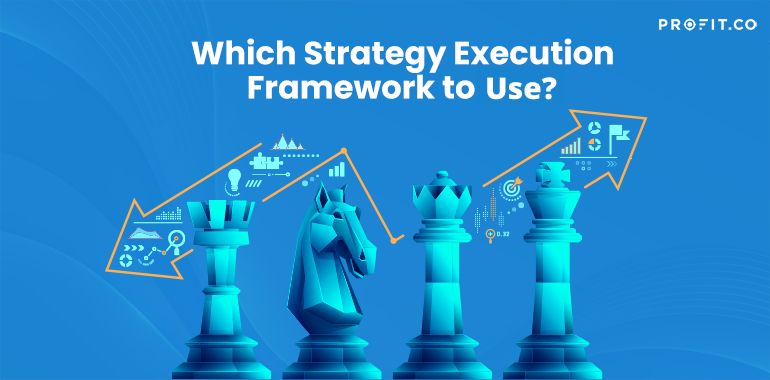Before we recommend an approach for executing your strategy, let’s delve deeper into the world of strategy execution in two steps:
1. Layout the common theme amongst all the popular strategy execution frameworks
2. Investigate some strategic frameworks for business units to understand how they bring out this common theme.
Without these frameworks, businesses typically track their KPIs (key performance indicators) in different systems such as CRM systems, ticketing systems, and task systems. While dashboards provide a view of where the business stands at a certain point in time, they do not drive management down the chain to help people make micro-decisions at various levels and do the work.
Growth & Scaling
At the core of any successful business is the desire to grow and scale. At the heart of this desire for growth lies the fundamental belief that we can always do better, that we can always improve our performance and achieve greater success. This is why we constantly seek ways to optimize our strategies, refine our processes, and push ourselves to the limit.
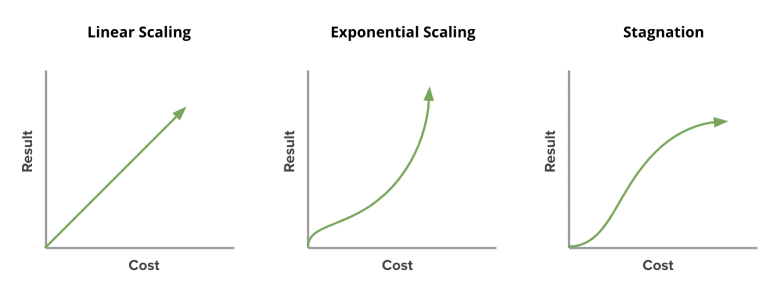
Linear scaling refers to steady growth, where output increases in proportion to input. Exponential scaling, on the other hand, is a pattern of growth in which the output increases rapidly over time. While linear scaling can be reliable, exponential scaling has the potential to create a significant impact and bring about exponential growth.
Stagnation, on the other hand, is a lack of growth or progress, which could lead to stagnation in business or personal life. In summary, linear scaling provides predictable growth, exponential scaling offers significant growth potential, while stagnation can lead to a lack of progress or decline.

Business Optimization Equation
Achieving exponential growth is not just about individual efforts, it’s also about leveraging the synergies between individuals and reducing organizational waste. To do this, it is essential to understand the simple equation that defines business performance:

Individual performance refers to the contributions of each person in the organization toward achieving the overall goals of the business. It is important to recognize that the sum of individual performances is greater than the sum of individual outputs. This is because when individuals work together in a collaborative environment, their collective performance becomes greater than the sum of their individual efforts.
Synergies, on the other hand, refer to the benefits that arise from the collaboration between individuals or teams. Synergies are created when different parts of the business work together in a coordinated manner to achieve a common goal. When synergies are leveraged effectively, they can lead to exponential growth.
Organizational waste, however, is the antithesis of growth. It refers to any inefficiencies or inefficacies in the organization that result in wasted resources, time, or effort. Examples of organizational waste include redundant processes, duplicated efforts, and ineffective communication.
By minimizing organizational waste and maximizing the sum of individual performances and synergies, businesses can achieve exponential growth while executing organizational strategy. However, this requires a concerted effort from everyone in the organization. It is not enough for just a few individuals to excel; everyone must be aligned and working towards a common goal.
To achieve exponential growth, businesses must focus on leveraging synergies between individuals and minimizing organizational waste while maximizing the sum of individual performances.
Whenever you see a successfull business, someone once made a courageous decesion.
KPIs & Activities
At the core of every business, there are key performance indicators (KPIs) that every manager, senior manager, and C-level executive are interested in measuring and managing. These KPIs provide a glimpse into how well the business is performing and help determine the next steps. To move these KPIs, managers typically undertake a series of initiatives or activities to achieve their goals.
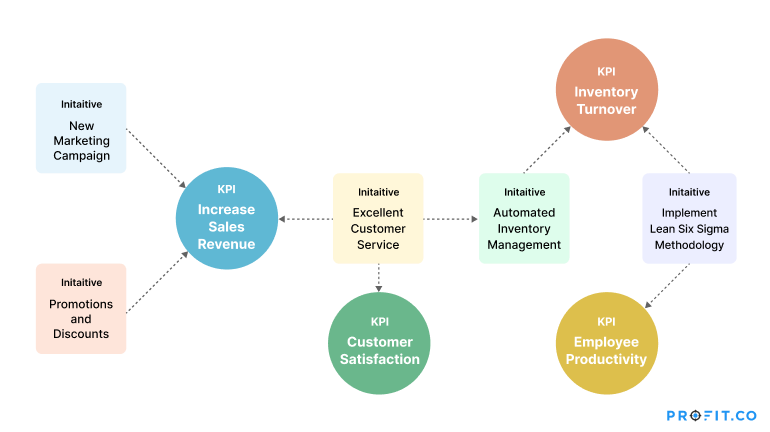
For example, KPIs may be the focus of a business, and initiatives may be the steps taken to improve these KPIs. Managers can effectively run their businesses by establishing a connection between initiatives and KPIs.
However, in practice, the tracking of work can become complicated. Businesses often use different systems to keep track of work, such as CRM, ticketing, and task systems. They may also use external subscription systems and internal systems to track work. In addition, dashboarding capabilities are often used to bring together KPIs from various systems and display them in a user-friendly dashboard.

While dashboards are useful for providing an overview of performance, they do not necessarily drive management down the chain in an organization. They do not help employees make micro-decisions at various levels or facilitate the actual execution of work.
Ready to start your journey of continuous improvement?
Hoshin Kanri
Hoshin Kanri is a strategic planning methodology developed in Japan in the 1960s. It is also known as Policy Deployment, which means aligning the company’s objectives with the policies, systems, and resources required to achieve them. The ultimate goal of Hoshin Kanri is to create a shared vision and direction for an organization, with every employee involved in the process of achieving it.
The Hoshin Kanri process is divided into several steps. First, the company establishes its long-term strategic goals and objectives. Next, a strategy is developed that outlines how the company will achieve these goals. This is followed by the development of annual objectives, which are specific and measurable targets for each department or individual within the company. These objectives are then translated into action plans, which outline the specific activities that need to be undertaken to achieve the objectives.
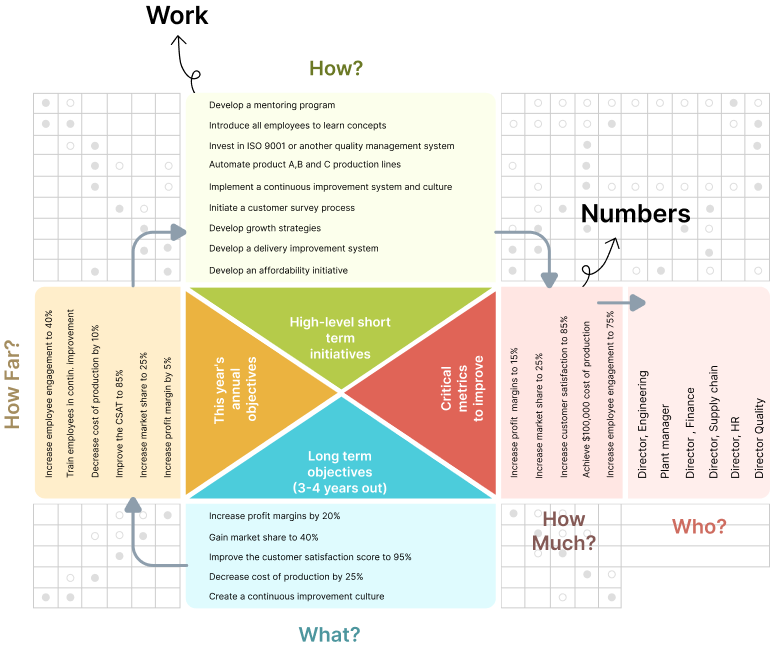
Source: LinkedIn
One of the key features of Hoshin Kanri is the use of “catchball” to communicate the company’s objectives throughout the organization. Catchball is a dialogue-based process that involves a back-and-forth exchange of ideas between managers and employees. Through this process, the objectives are refined and adapted to ensure that they are achievable and that everyone is aligned with the company’s overall vision.
Hoshin Kanri also emphasizes continuous improvement and learning. By regularly reviewing progress and analyzing results, the company can adjust its strategy and objectives to ensure that it remains on track. This involves a “PDCA” (Plan-Do-Check-Act) cycle, where the company plans its objectives, implements them, checks progress, and makes adjustments as needed.
Overall, Hoshin Kanri is a comprehensive and systematic approach to strategic planning that involves everyone in the organization. By aligning the company’s objectives with the actions of every employee, Hoshin Kanri helps create a shared vision and direction for the company, leading to improved performance and results.
OGSM
OGSM is a framework that stands for a strategic planning tool that is widely used by organizations to align their business goals with their vision, mission, and values. OGSM helps organizations to create a roadmap for achieving their objectives by defining specific goals, identifying strategies to achieve them, and establishing measures to track progress.
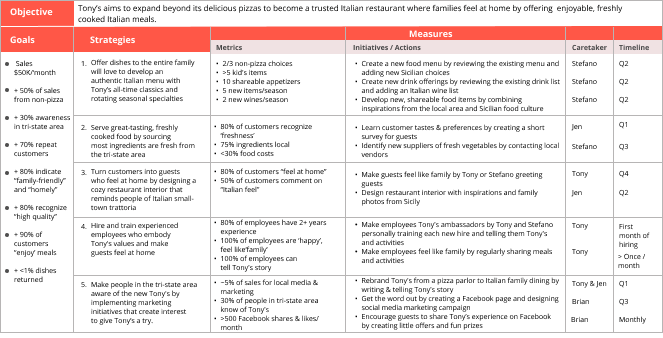
Source: Rock your Strategy
The OGSM framework consists of four components:
1. Objectives: Objectives are the desired outcomes that an organization wants to achieve. They should be specific, measurable, achievable, relevant, and time-bound. Objectives should be aligned with the organization’s vision and mission, and they should be challenging but attainable.
2. Goals: Goals are specific targets that need to be accomplished to achieve the objectives. Goals should be SMART – specific, measurable, achievable, relevant, and time-bound. They should be aligned with the organization’s objectives and should be broken down into smaller, achievable targets.
3. Strategies: Strategies are the approaches or plans that an organization uses to achieve its goals. Strategies should be actionable, realistic, and feasible. They should be aligned with the organization’s goals and should be broken down into smaller, actionable steps.
4. Measures: Measures are the metrics used to track progress toward achieving goals. Measures should be specific, measurable, and relevant. They should be aligned with the organization’s goals and objectives and should be regularly reviewed and updated.
OGSM provides a structured approach to strategic planning, which helps organizations to focus their efforts and resources on achieving their objectives. It helps organizations to identify gaps in their current strategy, define specific goals, and establish measures to track progress toward achieving them. By using OGSM, organizations can improve their decision-making processes, ensure that everyone is aligned with the organizational goals, and improve overall performance.
Balanced Scorecard
The Balanced Scorecard (BSC) is a strategic management framework that helps organizations to align their goals, strategies, and actions with their vision and mission. It provides a comprehensive view of an organization’s performance by measuring key performance indicators (KPIs) across four perspectives: financial, customer, internal business processes, and learning and growth.
The financial perspective of the BSC focuses on achieving financial objectives such as revenue growth, profitability, and return on investment. The customer perspective emphasizes customer satisfaction, retention, and acquisition to ensure a strong customer base. The internal business process perspective measures the effectiveness and efficiency of internal processes that create value for customers, while the learning and growth perspective focuses on developing the organization’s capabilities and talent to sustain long-term growth.
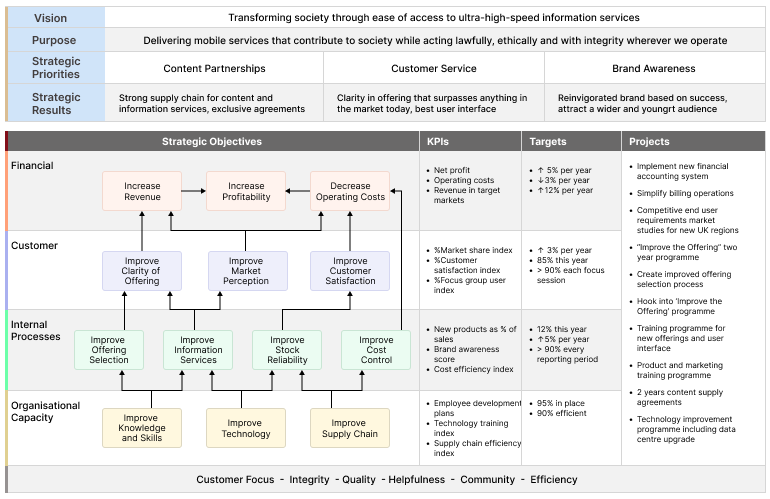
Image Credits: intrafocus
The BSC translates an organization’s vision and strategy into actionable objectives, targets, and measures. It helps to identify and prioritize initiatives that align with the organization’s strategy and objectives. By tracking and analyzing KPIs across the four perspectives, the BSC provides a balanced view of the organization’s performance, helping managers to make informed decisions.
The BSC has been widely adopted by organizations in various industries, including healthcare, government, education, and nonprofit organizations. It is a flexible framework that can be adapted to different organizational structures, sizes, and industries. The BSC has evolved over the years to incorporate new trends and practices, such as sustainability and corporate social responsibility.
Overall, the BSC is a powerful tool that helps organizations to achieve their strategic objectives by aligning their goals, strategies, and actions with their vision and mission. It provides a holistic view of an organization’s performance, helping managers to make informed decisions and prioritize initiatives that create long-term value.
Objectives and Key Results (OKRs)
While these frameworks can be complex and not very easy to push down the organization, OKRs (objectives and key results) are a simpler concept that can be easily pushed down to even an individual contributor level. And so, if you don’t have any framework, we recommend the OKR framework. Because it is a simpler framework, OKRs need to be constructed in a certain package structure to derive value from their usage. A lagging indicator key result can make OKRs powerful by telling businesses if there’s a problem when the other key results are progressing. Let’s look at a simple example:
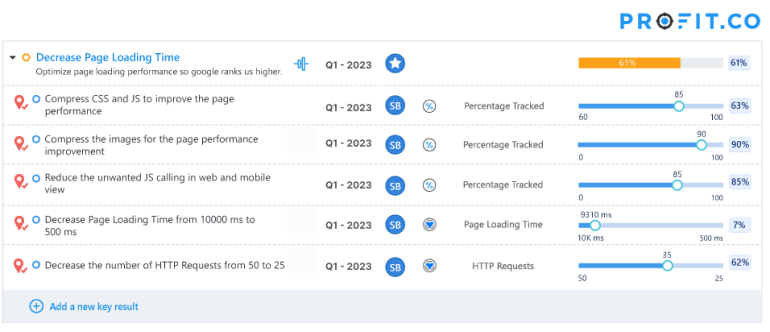
This example has five key results that contribute to decreasing the page loading time. Four of them are initiatives: key results one, two, three, and five are all initiatives. The fourth one is the “lagging indicator” type of key result. Packaging it like this is essential to ensure you get the best out of your OKRs. If you don’t package it like this, you won’t realize the power of OKRs.
So, if we left out the lagging indicator key result, this OKR would still look fine, you would continue to execute, and you’ll feel good about your accomplishments; you’ll declare victory. But you would have wasted your resources for no good. What makes it powerful here is the fourth key result, falling behind and not showing much progress. In contrast, the other four key results are progressing, which tells you there’s some problem.
Managing Using the OKR framework
While executing strategy with OKR the results can be summarized in a two-by-two matrix, with numbers on the Y-axis, work on the X-axis, and green and red on both. This matrix allows businesses to quickly identify if they are on track to meet their objectives or if any issues need addressing.
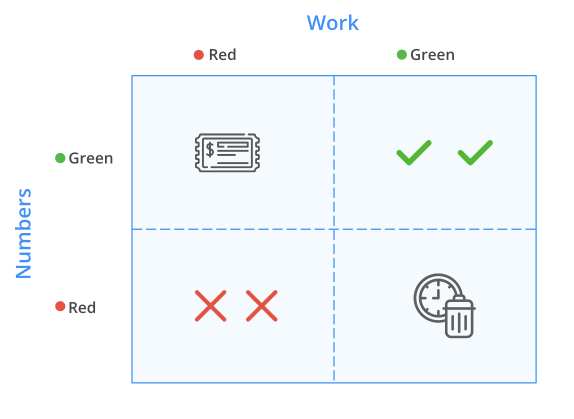
If your work and numbers are both green, then everything is going well. You are progressing toward your objectives, and there is no need to worry. However, if your work is red and your numbers are red, then you know you have a problem. The reason could be that the work has not been done correctly or the plan needs to be reevaluated. In either case, it is essential to address the issue quickly to get back on track.
On the other hand, if your work is red, but your numbers are green, you have essentially hit the jackpot. This could be due to external factors, luck, or other activities in the company impacting the KPIs or numbers. In this case, it is crucial to validate the results and make sure they are accurate. If they are, it is best to redirect your efforts to other projects and initiatives that will have a greater impact.
Similarly, the other anomaly is when your work is green, but your numbers are red. This situation requires introspection and an understanding of why your initiatives are not impacting the numbers as expected. You need to be willing to fail fast and try different approaches until you achieve the desired outcomes. As Thomas Edison once said, “I have not failed. I’ve just found 10,000 ways that won’t work.” This mindset is crucial to finding the right solutions that will help you achieve your objectives.
Effective management systems should help businesses put their KPIs and work in this matrix, visualize their progress, and make necessary changes to their initiatives. Regularly performing this analysis is essential to ensure that businesses are maximizing their results and minimizing waste. By doing so, businesses can identify the best initiatives to pursue, double down on them, realign or change others, and trash those that are not working. This introspection and analysis will help businesses achieve their goals efficiently and effectively, reducing waste and maximizing their impact.
Conclusion
In conclusion, selecting an appropriate strategy execution framework is a significant decision that must resonate with your organization’s strategic objectives, internal culture, and unique needs. Rather than adopting a fragmented approach of combining elements from various frameworks, choosing one framework that most suitably aligns with your organization’s circumstances can be more advantageous. Remember, the best framework is the one that complements your unique situation and supports your strategic direction. Effective strategy execution is not solely about implementing a framework—it fundamentally requires robust leadership, a supportive culture, and a relentless commitment to aligning strategy with execution.
Ready to start your journey of continuous improvement?
Related Articles
-
Profit.co is FedRAMP Ready. Trusted Execution for Federal Agencies Just Got Simpler
In a world where data security, compliance, and mission success are non-negotiable, Profit.co stands out as a trusted partner for... Read more
-
Tim Newbold: Drive OKR Outcomes with Confidence Scoring
You're not alone if you're unsure how confident your team is about achieving its OKRs this quarter. Many teams operate... Read more
-
Tim Newbold on Leading Outcome-Obsessed Teams with OKRs
In many team meetings, a recurring pattern emerges Team members provide updates such as, “I completed tickets 247 and 248,”... Read more
-
How Top Teams Win with Weekly OKR Check-Ins – Insights from Tim Newbold
Set a goal. Cross your fingers. Hope for the best.Sounds familiar?That’s how too many teams treat OKRs. They set goals,... Read more
